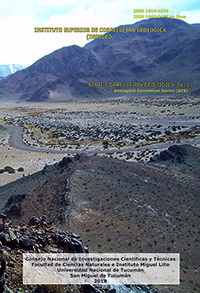Serie Correlación Geológica 34 (2)
Potencialidad del geoturismo en la Patagonia: Sitios de interés geológico en proximidad de la Ruta Nacional 40, tramo Río Turbio - Lago Viedma, Santa Cruz.
Elizabeth Mazzoni | Paula Diez
Descargar trabajo en formato PDFResumen
Se realiza un inventario y caracterización de posibles sitios de interés desde el punto de vista geoturístico a lo largo de la Ruta Nacional 40 en un tramo de 380 km comprendido entre la localidad de Río Turbio y el Lago Viedma en la Provincia de Santa Cruz. El área se ubica en la franja de transición entre el ambiente de meseta con clima semiárido al E y el ambiente cordillerano subhúmedo a húmedo al O. En la diversidad de paisajes que presenta, se identificaron ocho sitios que permiten observar y explicar procesos de modelado glacial, fluvial, eólico, volcánico, litoral-lacustre y de remoción en masa, algunos a escala de detalle, como así también observar rasgos estructurales y restos paleontológicos. Estos sitios poseen potencialidades no sólo vinculadas con el interés geológico (científico y educativo) sino que además permiten la práctica de diversas actividades y modalidades turísticas no convencionales, como turismo de aventura, trekking y safaris fotográficos, entre otros. Los resultados obtenidos constituyen un primer paso en el proceso de selección y jerarquización de geositios, como una herramienta para diversificar la oferta turística y la economía de la región.
Abstract
POTENTIALITY OF GEOTOURISM IN PATAGONIA: SITES OF GEOLOGICAL INTEREST IN THE PROXIMITY OF THE NATIONAL ROUTE 40, RÍO TURBIO - VIEDMA LAKE, SANTA CRUZ. An inventory and characterization of possible sites of interest from the geotouristic point of view was done along the National Route 40 in a section of 380 km between the town of Río Turbio and Lake Viedma in the Province of Santa Cruz. The area is located in the transition zone between the tableland environment with semi-arid climate to the E and the subhumid to humid mountain environment to the W. In the diversity of landscapes that it presents, eight sites were identified that allow observing and explaining glacial, fluvial, aeolic, volcanic, littoral-lacustrine and mass movement processes, some of them at a detailed scale, as well as observing structural features and paleontological remains. These sites have the potential, not only linked to geological interest (scientific and educational), but also allow the practice of various activities and non-conventional modalities, such as adventure tourism, trekking and photographic “safaris”, among others. The results constitute a first step in the process of selection and hierarchy of geosites, as a tool to diversify the tourist offer and the economy of the region.






